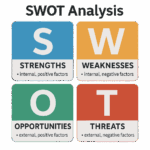When buying a business, performing a SWOT analysis helps assess its current position, identify risks, and uncover growth potential. Here’s how each component applies:
1. Strengths (Internal, Positive)
Internal advantages that make the business appealing:
- Strong brand recognition
- Loyal customer base
- Stable revenue and cash flow
- Skilled workforce
- Proprietary products or systems
- Desirable location
2. Weaknesses (Internal, Negative)
Internal shortcomings that may impact performance:
- High owner dependency
- Outdated systems or equipment
- Poor financial records
- High employee turnover
- Lack of online presence
3. Opportunities (External, Positive)
External trends or areas for potential growth:
- New markets or demographics
- Adding digital sales channels
- Improved marketing strategies
- Operational streamlining
- Expanding product/service offerings
4. Threats (External, Negative)
External risks that may impact the business:
- Competitive pressure
- Economic downturns
- Regulatory changes
- Supply chain disruptions
- Shifts in customer behavior
Why SWOT Matters
SWOT analysis provides a balanced view of the business’s strengths and vulnerabilities. It helps you:
- Make informed acquisition decisions
- Justify or negotiate the asking price
- Identify growth and improvement areas
- Anticipate and prepare for potential risks
Why Perform a SWOT Analysis?
- Gain Deep Insight: Understand the true value and challenges of the business.
- Uncover Competitive Advantages: Identify assets and strengths you can leverage.
- Spot Weaknesses: Reveal internal issues that could impact performance.
- Explore Growth Opportunities: Discover ways to expand or improve the business.
- Mitigate Risks: Prepare for external threats and challenges.
- Support Valuation & Negotiation: Use findings to back your purchase offer or terms.
- Plan Post-Acquisition Strategy: Create a focused action plan for success.
Steps to Perform a SWOT Analysis
1. Gather Information
Collect relevant data about the business, including financials, operations, customer base, competitors, and industry trends.
2. Identify Strengths
What does the business do well?
- Strong brand and reputation
- Loyal customer base
- Skilled team or management
- High profit margins
- Strategic location or proprietary technology
3. Identify Weaknesses
What are the internal limitations or areas of concern?
- Dependence on the owner
- Poor financial documentation
- Weak online presence
- Outdated equipment or processes
- Low employee morale or high turnover
4. Identify Opportunities
What external factors could boost business performance?
- Expanding markets
- New product lines
- Technology upgrades
- Strategic partnerships
- Cost-saving measures
5. Identify Threats
What external risks could negatively impact the business?
- Industry downturn
- Increased competition
- Changing regulations
- Economic recession
- Supply chain instability
SWOT Matrix
| Positive | Negative | |
|---|---|---|
| Internal | Strengths What the business does well |
Weaknesses Internal limitations |
| External | Opportunities External chances for growth |
Threats External risks and challenges |
Apply Your SWOT Findings
- Use strengths to create leverage and add value.
- Plan to correct or manage weaknesses before they become problems.
- Capitalize on opportunities for growth and differentiation.
- Develop strategies to minimize or avoid threats.
- Refine your offer and negotiation approach.
- Build a detailed action plan for the first 90 days after acquisition.



